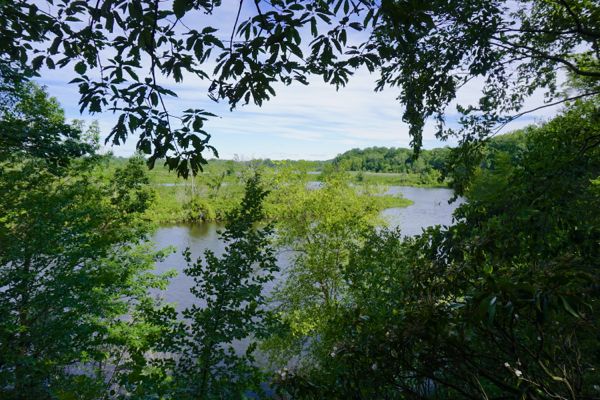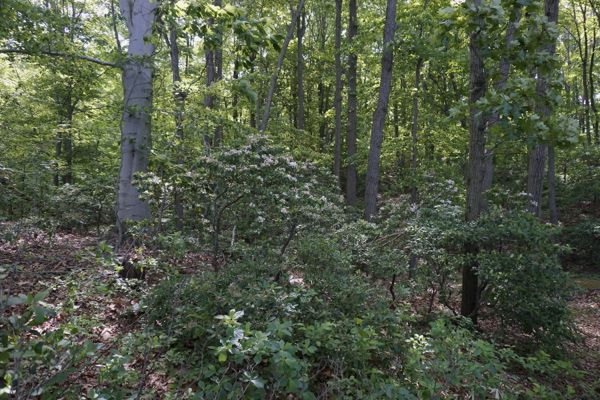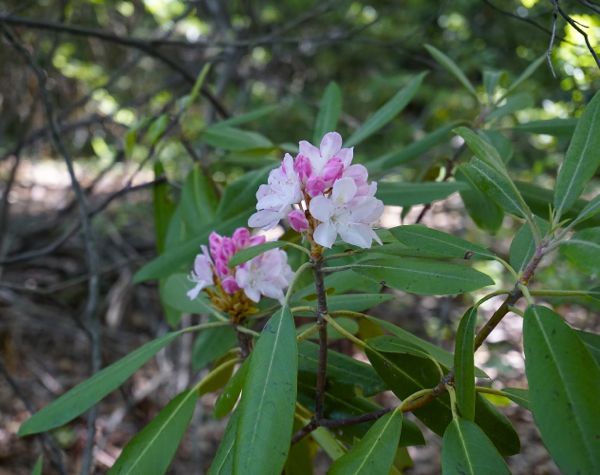Spectacular Flowering Mountain Laurel and Wild Rhododendron
Is timing of blooms impacted by climate change?

Bordentown Bluffs trail – Crosswicks creek peeks out – Trenton-Hamilton Marsh view. Abundant birds, including bald eagle and hawks (6/13/16)
[Update – 6/21/16 – out there this morning and rhododendron were in bloom – gorgeous, better than below visit.]
This morning I came across a group of fine folks from Friends for the Abbott Marshlands during our (i.e. me and Buoy) regular walks on the Bordentown Bluffs trail.
Some told me that they were out as a group especially to see the seasonal flowering mountain laurel and rhododendron.
I felt bad telling them that they missed the magnificent mountain laurel by almost 2 weeks – but that there were still small pockets of rhododendron still in flower.
I visited on June 7 and the mountain laurel were spectacular but seemed to be just past peak – but rhododendron were not yet out – During that walk, Buoy treed a gray fox and we must have been near a nest, because a red tail hawk screeched and swooped aggressively. [* more like hopping from treetop to treetop a half dozen times, then low altitude circling – screeching the whole time – than “swooping”.] Pissed I didn’t have my camera and tweeted a heads up: [* The snapping turtles who climbed up the almost vertical 40 foot bluffs to lay eggs were awesome too.]
I returned on June 13 with a camera, but the mountain laurel were past peak:
But the rhododendron were spectacular:
As the Friends group passed me on the bluffs trail this morning, I overheard a botanist showing and talking about native plants.
I’m no botanist or ecologist and I’ve only lived here for 4 years so have no historical context or data, but it seemed odd to me that the Friends had missed the prime flower bloom by almost 2 weeks.
It would seem that they would have some historical knowledge of the place and schedule their annual walk to observe the peak flowering.
Which made me think – is flowering occurring earlier due to climate change?
Organisms respond to changing climate in a multitude of ways, including through their phenology (the timing of key life history events such as flowering in plants or migration of birds), productivity (the assimilation of carbon and nutrients in biomass), spatial distribution, mortality / extinction, or by invading new territory. Noticeable changes may occur at the level of individual organisms, ecosystems, landscapes, or by modification of entire biomes.
Organisms and ecosystems are adapted to a variable environment, and they are capable to adapt to gradual change to some degree. Assessing confidence in the detection of such change involves therefore assumptions about natural variability in these ecosystems, while assessment of confidence in the attribution of detected change to climate drivers (or CO2 ) implies the assessment of confounding drivers such as pollution or land use change.
18.3.2.1.Phenology
Since the AR4 there has been a further substantial increase in observations, showing that hundreds of (but not all) species of plants and animals have changed functioning to some degree over the last decades to centuries on all continents (high confidence due to robust evidence but only medium agreement across all species; 4.3.2.1, Menzel et al. , 2006; Cook et al. , 2012b; Peñuelas et al. , 2013). New satellite-based analyses confirm earlier trends, showing, for example, that the onset of the growing season in the Northern Hemisphere has advanced by 5.4 days from 1982 to 2008 and its end has been delayed by 6.6 days (Jeong et al. , 2011). Significant changes have been detected, by direct observation, for many different species, for example, for amphibians (e.g., Phillimore et al. , 2010), birds (e.g., Pulido, 2007; Devictor et al. , 2008), mammals (e.g., Adamík and Král, 2008), vascular plants (e.g., Cook et al. , 2012a), freshwater plankton (Adrian et al. , 2009) and others (4.3.2.1); a number of new meta-analyses have been carried out summarizing this literature (e.g., Cook et al. , 2012a). Attribution of these changes to climate change is supported by more refined analyses that consider also the regional changes in several variables such as temperature, growing season length, precipitation, snow cover duration and others, as well as experimental evidence (Xu et al. , 2013). The high confidence in attributing many observed changes in phenology to changing climate is a result of these analyses, as well as of improved knowledge of confounding factors such as land use and land management (see also 4.3.2.1). ~~~~ IPCC
I didn’t get a chance to ask the Friends’ botanist – experts out there care to weigh in?




Pingback: WolfeNotes.com » View From the Crotch